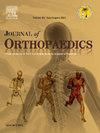Assessing joint line obliquity in valgus-producing high tibial osteotomy: A scoping review of the literature
IF 1.5
Q3 ORTHOPEDICS
引用次数: 0
Abstract
Background
The variance in knee joint line obliquity (KJLO) measurement methods and radiographic techniques may contribute to the controversy on clinical consequences of KJLO after high tibial osteotomy (HTO).
Purpose
To summarize currently used KJLO measurement methods, including their measurement reliability, and the radiographic techniques used in valgus-producing HTO.
Methods
The databases PubMed, Embase, and Web of Science were searched from inception up to May 2023, to identify articles that measured KJLO on radiographs in valgus-producing HTO.
Results
Thirty clinical articles were included. There were five different KJLO measurement methods reported, including joint line orientation angle by femoral condyles (JLOAF), joint line orientation angle by middle knee joint space (JLOAM), joint line orientation angle by tibial plateau (JLOAT), Mikulicz joint line angle (MJLA), and medial proximal tibial angle (MPTA), of which the JLOAT was the most commonly used. KJLO was measured on anteroposterior full-length standing radiographs with either single-leg or double-leg patient stance position, with no standardized bipedal distance on double-leg stance radiographs. Moderate-to-excellent measurement reliability was reported for intraobserver and interobserver MPTA, and good-to-excellent for intraobserver JLOAT and JLOAM and for interobserver JLOAT, JLOAM, and MJLA.
Conclusion
There is no consensus on how to measure KJLO or on which radiographic technique should be used. When measuring joint line orientation angles on anteroposterior full-length double-leg stance radiographs, controlling the bipedal distance with feet together is suggested when possible. Future research is needed to determine the measurement differences between the five KJLO measurement methods and to identify the preferred, ideal one.
求助全文
约1分钟内获得全文
求助全文
来源期刊

Journal of orthopaedics
ORTHOPEDICS-
CiteScore
3.50
自引率
6.70%
发文量
202
审稿时长
56 days
期刊介绍:
Journal of Orthopaedics aims to be a leading journal in orthopaedics and contribute towards the improvement of quality of orthopedic health care. The journal publishes original research work and review articles related to different aspects of orthopaedics including Arthroplasty, Arthroscopy, Sports Medicine, Trauma, Spine and Spinal deformities, Pediatric orthopaedics, limb reconstruction procedures, hand surgery, and orthopaedic oncology. It also publishes articles on continuing education, health-related information, case reports and letters to the editor. It is requested to note that the journal has an international readership and all submissions should be aimed at specifying something about the setting in which the work was conducted. Authors must also provide any specific reasons for the research and also provide an elaborate description of the results.
 求助内容:
求助内容: 应助结果提醒方式:
应助结果提醒方式:


